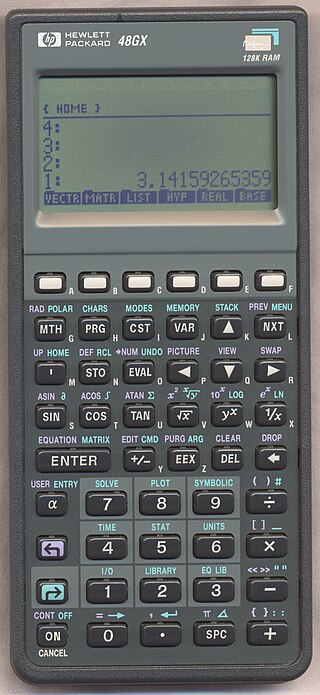
mIRC is an Internet Relay Chat (IRC) client for Windows, created in 1995. It is a fully functional chat utility and its integrated scripting language makes it extensible and versatile.

HP-UX is Hewlett Packard Enterprise's proprietary implementation of the Unix operating system, based on Unix System V and first released in 1984. Current versions support HPE Integrity Servers, based on Intel's Itanium architecture.

A screensaver is a computer program that blanks the display screen or fills it with moving images or patterns when the computer has been idle for a designated time. The original purpose of screensavers was to prevent phosphor burn-in on CRT or plasma computer monitors. Though most modern monitors are not susceptible to this issue, screensaver programs are still used for other purposes. Screensavers are often set up to offer a basic layer of security by requiring a password to re-access the device. Some screensaver programs also use otherwise-idle computer resources to do useful work, such as processing for volunteer computing projects.

The HP 48 is a series of graphing calculators designed and produced by Hewlett-Packard from 1990 until 2003. The series includes the HP 48S, HP 48SX, HP 48G, HP 48GX, and HP 48G+, the G models being expanded and improved versions of the S models. The models with an X suffix are expandable via special RAM and ROM cards. In particular, the GX models have more onboard memory than the G models. The G+ models have more onboard memory only. The SX and S models have the same amount of onboard memory.

The HP 49/50 series are Hewlett-Packard (HP) manufactured graphing calculators. They are the successors of the popular HP 48 series.
The NX bit (no-execute) is a technology used in CPUs to segregate areas of memory for use by either storage of processor instructions or for storage of data, a feature normally only found in Harvard architecture processors. However, the NX bit is being increasingly used in conventional von Neumann architecture processors for security reasons.

BitComet is a cross-protocol BitTorrent, HTTP and FTP client written in C++ for Microsoft Windows and available in 52 different languages. Its first public release was version 0.28. The current BitComet logo has been used since version 0.50.
BitTorrent is a proprietary adware BitTorrent client developed by Bram Cohen and Rainberry, Inc. used for uploading and downloading files via the BitTorrent protocol. BitTorrent was the first client written for the protocol. It is often nicknamed Mainline by developers denoting its official origins. Since version 6.0 the BitTorrent client has been a rebranded version of μTorrent. As a result, it is no longer open source. It is currently available for Microsoft Windows, Mac, Linux, iOS and Android. There are currently two versions of the software, "BitTorrent Classic" which inherits the historical version numbering, and "BitTorrent Web", which uses its own version numbering.

Yoot Tower is a 1998 construction and management simulation computer game. It may be considered the spiritual successor to the 1994 game SimTower.
Printer Command Language, more commonly referred to as PCL, is a page description language (PDL) developed by Hewlett-Packard as a printer protocol and has become a de facto industry standard. Originally developed for early inkjet printers in 1984, PCL has been released in varying levels for thermal, matrix, and page printers. HP-GL/2 and PJL are supported by later versions of PCL.
Free Download Manager is a download manager for Windows, macOS, Linux and Android.

The Hewlett-Packard Voyager series of calculators were introduced by Hewlett-Packard in 1981. All members of this series are programmable, use Reverse Polish Notation, and feature continuous memory. Nearly identical in appearance, each model provided different capabilities and was aimed at different user markets.
Criticism of Windows XP deals with issues with security, performance and the presence of product activation errors that are specific to the Microsoft operating system Windows XP.

HP Labs is the exploratory and advanced research group for HP Inc. HP Labs' headquarters is in Palo Alto, California and the group has research and development facilities in Bristol, UK. The development of programmable desktop calculators, inkjet printing, and 3D graphics are credited to HP Labs researchers.

The HP-15C is a high-end scientific programmable calculator of Hewlett-Packard's Voyager series produced between 1982 and 1989.
Zune is a discontinued media management software program for Microsoft Windows that functions as a full media player application with a library, an interface to the Zune Marketplace, and as a media streaming server. The software is used to sync with all devices with Zune functionality including the Zune 4, 8, 16, 30, 80, 120, Zune HD, Windows Phone 7, and Microsoft Kin. Zune devices work exclusively with the Zune software, which applies many design principles of Microsoft's Metro design language.

BOINC client–server technology refers to the model under which BOINC works. The BOINC framework consists of two layers which operate under the client–server architecture. Once the BOINC software is installed in a machine, the server starts sending tasks to the client. The operations are performed client-side and the results are uploaded to the server-side.
Mscape was a mobile media gaming platform developed by Hewlett Packard that could be used to create location-based games. The development of Mscape was discontinued on March 31, 2010.

TREK73 is a computer game based on the original Star Trek television series. It was created in 1973 by William K. Char, Perry Lee, and Dan Gee for the Hewlett-Packard 2000 minicomputer in HP Time-Shared BASIC. The game was played via teletype. Trek73 is so big that it needs the CHAIN feature of HP2000 BASIC.
In computing HP Roman is a family of character sets consisting of HP Roman Extension, HP Roman-8, HP Roman-9 and several variants. Originally introduced by Hewlett-Packard around 1978, revisions and adaptations were published several times up to 1999. The 1985 revisions were later standardized as IBM codepages 1050 and 1051. Supporting many European languages, the character sets were used by various HP workstations, terminals, calculators as well as many printers, also from third-parties.












